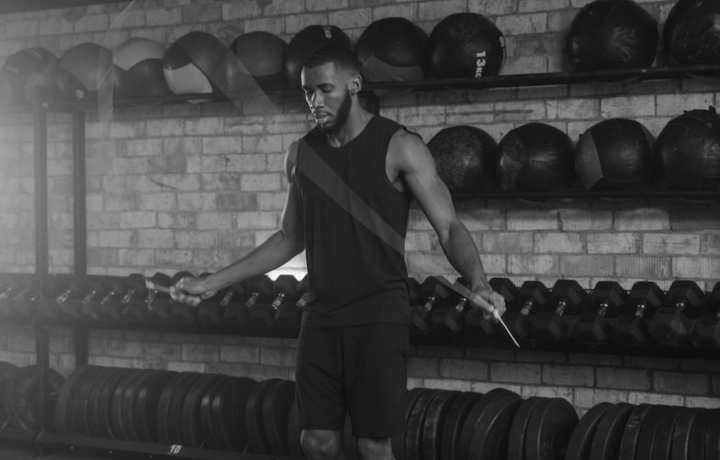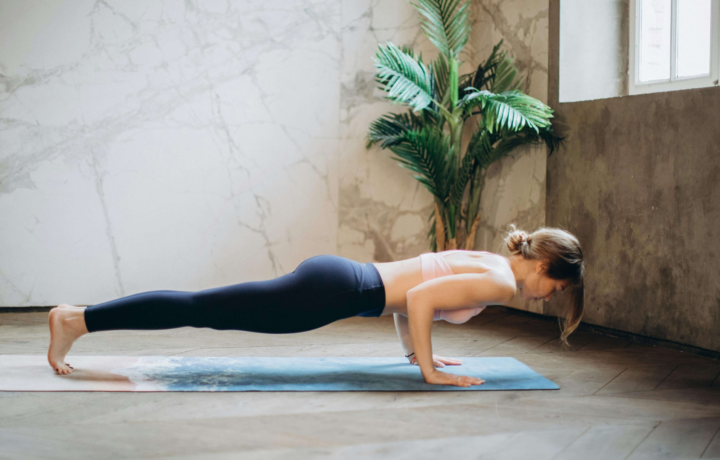Exercise
Burpee

Burpee
How to Perform
- Start in a standing position with your feet hip-width apart, arms at your sides, and your core engaged.
- Bend your knees, push your hips back, and place your hands flat on the ground directly in front of your feet while keeping your spine neutral.
- Jump or step your feet back to land in a high plank position with your hands directly under your shoulders, forming a straight line from head to heels.
- Lower your chest to the floor by bending your elbows, keeping them close to your body in a push-up motion while inhaling.
- Push through your palms to extend your arms and return to the high plank position while exhaling, maintaining a rigid torso and engaged core.
- Jump or step your feet forward to land just outside your hands, dropping your hips low into a squat position.
- Drive through your heels, extend your hips and knees to explosively jump upward while reaching your arms overhead, fully exhaling at the top.
- Land softly with your knees slightly bent to absorb the impact, immediately transitioning into the next repetition by bending your knees again.
Important information
- Keep your core engaged throughout the entire movement to protect your lower back, especially during the plank and push-up portions.
- Land softly on the balls of your feet when jumping to minimize joint stress, and always maintain proper wrist alignment under your shoulders during the plank.
- Modify the exercise by stepping rather than jumping if you're a beginner or have joint issues, and remove the push-up component if needed.
- Maintain a consistent breathing pattern, exhaling during exertion (jumping up, pushing up) and inhaling during the descent phases.

Burpee
Exercise Details
Primary Muscles
Muscle Groups
Mechanic
Risk Areas
Built for progress
Take the guesswork out of training
Create personalized AI-powered workout plans that evolve with you. Train smarter, track every rep and keep moving forward, one workout at a time.






The burpee stands as one of fitness's most celebrated and simultaneously dreaded movements. This compound exercise has earned its reputation as a high-intensity staple that delivers comprehensive benefits in minimal time. Originally developed in the 1930s by physiologist Royal H. Burpee as a fitness test, this movement has evolved to become a cornerstone in modern workout programs across various fitness disciplines.
While beginners can attempt modified versions, the traditional burpee requires a moderate fitness foundation. The exercise demands coordination between multiple movement patterns and sufficient strength to transition smoothly between positions. Intermediate exercisers will find burpees challenging yet achievable, making them perfect for progressive overload as fitness improves.
The burpee excels at activating multiple muscle groups simultaneously. Your core muscles (rectus abdominis, obliques, and transverse abdominis) work continuously to stabilize your body throughout the movement. The quadriceps power your jump and assist in the stand-up portion, while your glutes activate strongly during the explosive component. Beyond muscle engagement, your cardiovascular system works overtime, elevating heart rate quickly and efficiently.
Burpees feature prominently in High-Intensity Interval Training (HIIT) protocols, where they deliver maximum metabolic impact in short time frames. Their versatility makes them ideal for Tabata intervals, EMOM (Every Minute On the Minute) challenges, and AMRAP (As Many Rounds As Possible) formats. In CrossFit, burpees appear regularly in benchmark workouts and the CrossFit Games, testing athletes' power endurance and mental fortitude.
Few exercises match the burpee's efficiency for cardiovascular development. Regular incorporation improves VO2 max, cardiac output, and overall endurance capacity. The full-body nature of the movement creates a significant oxygen demand, training your body to utilize oxygen more efficiently during exercise. This translates to improved stamina across other athletic pursuits and daily activities.
FAQ - Burpee
Burpees engage nearly your entire body, with primary emphasis on your quadriceps, glutes, chest, shoulders, and core. Your cardiovascular system also receives significant training, making burpees one of the most efficient full-body exercises available.
Begin with step-back burpees (stepping instead of jumping feet back), eliminate the push-up portion, or reduce the jump at the top to a simple stand. As you build strength and coordination, gradually add components back until you can perform the full movement with proper form.
For beginners, start with 3-4 sets of 5-8 reps with adequate rest between sets. Intermediate fitness levels can aim for 10-15 reps per set or timed intervals of 30-45 seconds. Quality always trumps quantity—maintain proper form throughout.
The three most frequent errors include allowing your lower back to sag during the plank position, landing with locked knees after the jump, and rushing through repetitions with poor technique. Focus on maintaining a neutral spine, soft knee landings, and controlled movements throughout.
For optimal results without overtraining, include burpees 2-3 times weekly with at least 48 hours between high-intensity burpee sessions. They work exceptionally well as part of a metabolic circuit or as a standalone conditioning finisher after strength training.












